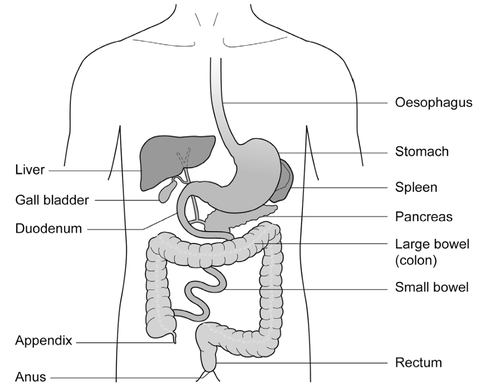Having a flexible sigmoidoscopy as an inpatient
You have been advised to have a flexible sigmoidoscopy to help investigate the cause of your symptoms. It is important that you read this page before you have the procedure so that you understand what will happen and the preparation involved.
What is a flexible sigmoidoscopy?

Flexible sigmoidoscopy is a test which allows the doctor to look at the lower part of your large bowel (sigmoid colon). A flexible colonoscope is passed through the anus (back passage) and into the bowel.
A colonoscope is a flexible tube about the thickness of your index finger with a bright light on the end.
By looking at the screen, the doctor can see the lining of the bowel and check whether any disease is present.
Biopsy
Sometimes the doctor will take a biopsy, a small sample of tissue, to be examined in the laboratory.
It is also possible to remove polyps during the flexible sigmoidoscopy. Polyps are abnormal bits of tissue, like warts, which the doctor will want to examine in more detail afterwards in the laboratory.
Preparation for your procedure
The test and possible complications will have already been explained to you so that you understand the procedure and any risks involved.
You will be asked to sign a consent form by the ward doctor. By signing this form, you will have agreed to have the test performed and that you understand why it is needed. This does not take away your right to have the test stopped at any time.
To allow a clear view during the procedure the bowel must be cleaned and empty for this test. You will be given an enema about an hour before you are taken to the Endoscopy Unit for the flexible sigmoidoscopy. You will be able to continue to eat and drink normally.
On arrival at the Endoscopy Unit
You will be seen by a nurse who will check your paperwork and record your observations.
You will then be taken into the room where your sigmoidoscopy will take place. Depending on how you have travelled to the Endoscopy Unit, you will either be on your hospital bed or one of the Endoscopy trolleys. You will be made comfortable, lying on your left side with your knees bent. A nurse will stay with you throughout the procedure.
During the test
- A rectal examination may be done as part of the procedure. This is where a doctor uses their finger to check for any problems inside your bottom(rectum). It is usually very quick and you should not feel any pain.
- When the tube has been gently inserted through your anus into the large bowel, air will be passed through it to give a clear view of the lining. This may give you some wind like pains but will not last long.
- You may also get the sensation of wanting to go to the toilet. As the bowel is empty, there is no danger of this happening. You may pass some wind but please do not be embarrassed.
- Sometimes a nurse will assist the endoscopist by applying some pressure to your abdomen (tummy) with their hand. This can often help the endoscope to progress through your bowel more efficiently.
- The test usually takes between 5 and 10 minutes. When the test is finished, the tube is removed quickly and easily. Most of the air put in during the test will be taken out as the tube is removed.
If suitable, Entonox® (gas and air) is also available during the procedure either as an alternative to sedation or as well as sedation. This will help to control any discomfort. If you have experienced any of the following within the last 12 weeks, Entonox® will not be suitable for you.
- Pneumothorax
- Air embolism
- Bowel obstruction
- Head injury that has required an overnight stay in hospital
- Decompression sickness
Entonox will also not if suitable if:
- You have emphysema/COPD
- You have had recent ear/eye surgery
- You have been scuba diving in the last 12 weeks
Benefits of having a flexible sigmoidoscopy
- To diagnose and treat a possible cause of symptoms
- To review findings of any previous endoscopy
Possible risks
Complications with a flexible sigmoidoscopy are uncommon. Major complications are very rare.
- If a biopsy is taken or a polyp removed it can lead to bleeding or a perforation (a tear) in the bowel. Bleeding usually settles on its own. The risk of this happening is 1 in every 100 cases.
- A perforation may need major surgery. However, the risk of a complication such as this is small. The overall complication rate including perforation and bleeding is less than 1 in every 20,000 cases.
- The overall chance of missing something important such as a cancer.
- Abdominal discomfort mostly around the lower lefthand side of the abdomen.
- Adverse reaction to any medication given.